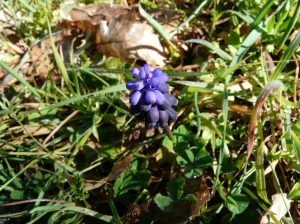
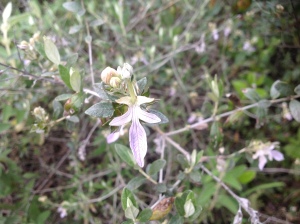
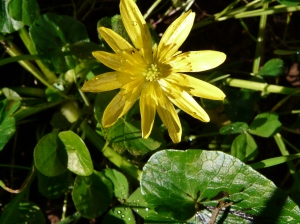
The first flowers and blossoms for early Spring have been the wild grape hyacinth and celandine. However, the wild Viburnum Tinus has been breaking into bud from January. The Teuchrium too and the simple gorse seem to keep a few flowers through the winter months and this seems to help the white tailed bumble bees. These two plants have been flowering for a long time but are full of their blossoms now.
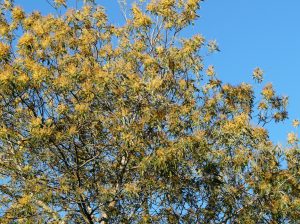
The mimosa was planted by a previous owner and is incredibly invasive. Very pretty in March but its roots come up everywhere near the house and created quite a jungle. I am concerned about trying to keep the native flora here as it is so pretty and well adapted to the climate. I really do not need to think about planting a garden even though I try and the frost seems to harm many plants. I am still finding my way with the climate here. We are a microclimate and lemon trees cannot grow here but will be fine about 6 miles away. I have lost quite a few plants to the February frosts. But the wild ones stay strong.
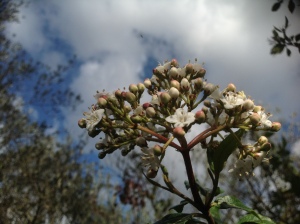

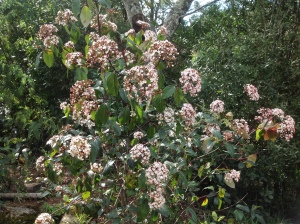
Now the semi wild plum blossoms are fading and the cherry is coming out. I think the Buff tailed bumblebees are now getting ready and taking advantage of the tree blossoms. In the chestnut orchards the wild peonies are beginning to bud, along with Solomons Seal and the dreaded bracken. There are also signs of many other wild flowers and hopefully the wild foxglove. More on these later.
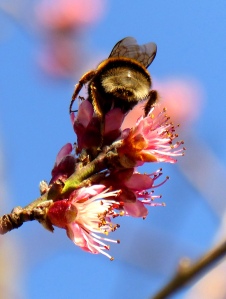
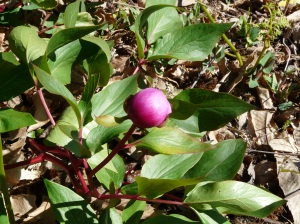
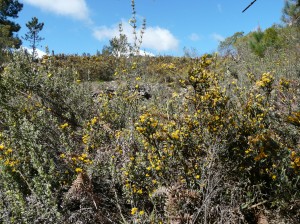
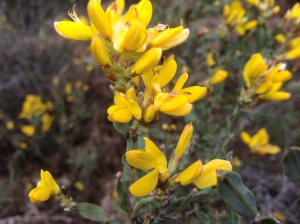 Genista sagittalis
Genista sagittalis
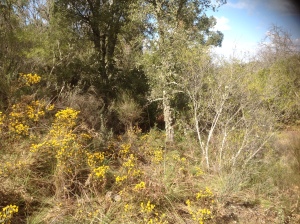
Up the east side of the valley is the yellow hillside. Here a different kind of gorse or broom is prevalent; arrow or genista sagittalis and is the first to flower in Spring followed by the Spanish broom. The common gorse isn’t found here and this hill becomes hot and dry in the summer and has a different flora to the valley and west side.
The blog ‘ Culture of Awareness‘ gave me a link to a plant identification app of Western Europe developed in France. Plant net. This has helped with some common flowers and a beautiful yellow Early Star of Bethlehem by the rocks at the front of the house.
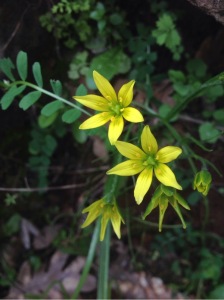

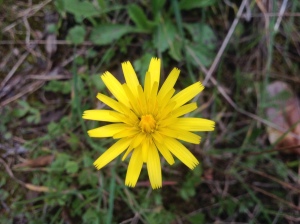
As I often say the birds are so wild here and it is difficult to photo them but we were very lucky to have a visiting flock of bullfinches. Near Ruth’s house are the golden Orioles , high up in the poplars. Too difficult to capture, yet! A little nearer to the house she managed a shot of a pretty warbler. These are quite common here. Many warblers have recently arrived from Africa although the chiff chaff might be resident. We have also heard the bee eaters high above with their high notes. Oh and of course the collection of Ravens which inspired my poem and many of the commoyn woodland birds. Blue, Great,long tailed and crested tits, robins, wrens, nuthatches, blackcaps, redstarts, goldcrests and a range of warblers. All fly around the old oak and cork nearby but they never stay long in one place! All are too busy to pose for a photo. Spring is here and so is the contrast of warm sunny days and heavy April showers.
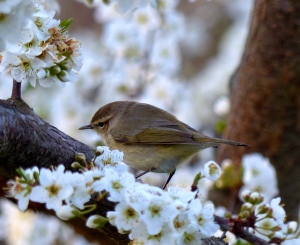
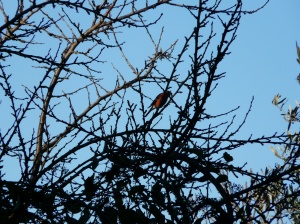

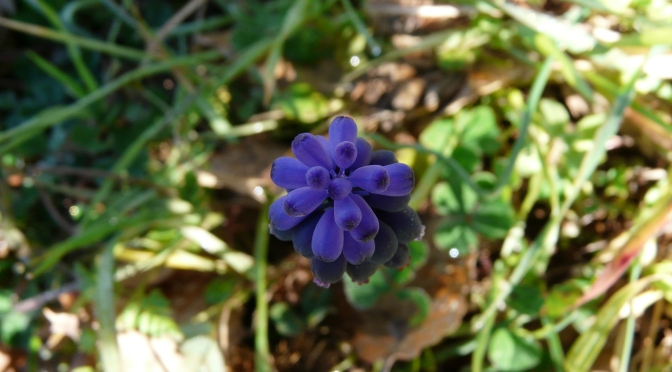
Looks like spring is well advanced where you are. Very cold here at the moment – good writing weather! How’s the novel?
LikeLiked by 2 people
The novel. Almost there but will need some careful editing!
LikeLiked by 1 person
Thanks for this info and lovely plant and insect photos. Spring is such a wonderful time of year – will be missing it in Oregon. We’re headed the other direction here in South Africa and the winter storms and wild seas will be with us soon.
LikeLiked by 1 person
Oh, well but you still have some fantastic sights to see!
LikeLike
Isn’t Spring a wonderful season. I’m intrigued by the peonies. We saw them for the first time on a walk the other day – dotted across fields. Are they native to the Iberian penisular?
LikeLiked by 2 people
I think it’s a good year for them. I have never seen as many as this on the Finca. They seem to like the chestnut tree roots. These ones are native to the Sierra and are Peoni Broteri. They are more open and ready for the pollinators than many of the highly cultivated ones.
LikeLiked by 1 person
Ahha! Thanks for that. They look so gorgeous under trees 😊
LikeLiked by 1 person
Beautiful pictures!
LikeLike
Spring is my favourite. As we are approaching winter here in Australia…reading this sure warmed my heart ❤❤❤
LikeLiked by 1 person
Hope your winter isn’t too bad!
LikeLike
Lovely… spring has brought on these wonderful flora and fauna! Interesting read.
LikeLiked by 1 person
Thanks and there’s even more changes happening. Hard to keep up!
LikeLiked by 1 person
Interesting, your spring is so close to ours. The chiff-chaff has recently arrived. The lesser celandine is flowering (and is a pain here), apart from the mimosa, we have much the same flora, teucrium, viburnam, grape hyacinths, peonies (tree in bud, that others not yet) and fauna.
LikeLiked by 1 person
Our part of the Sierra on the northern slope is very different to the south side. Much wetter! But so much more variety and greener in the summer. I sometimes call the area the Derbyshire of Spain!
LikeLike
Such a lovely collection of images .. Just love the bumble bees bottom! And that warbler .. Beautiful. Thanks for sharing
LikeLiked by 1 person
Thanks for sharing your pretty blooms with us – springtime is a wonderful season!
LikeLiked by 1 person
Thank you for the beautiful botanical tour you take us on. I so love nature.
LikeLiked by 1 person
Beautiful! I am currently enjoying spring in the Sonoran Desert where all the cacti and other desert plants are in bloom.
LikeLiked by 1 person
Looks fascinating, enjoy!
LikeLike
The yellow hillside looks like it would get a lot of insect activity now. I would like seeing it. When it gets hot and the plants change, is it still attracting insects?
LikeLiked by 1 person
This and until about July is a very busy time for the insects and flowers. I need to walk up with my camera but it’s been raining so much! Much needed though. There are always some insects about but from last year few bumblebees in July August. But thin waist wasps and solitary type bees.
LikeLike
Spring in Spain, my favourite season for wildflowers and birds on the move! Who needs ‘garden’ plants when the natives are so beautiful and bought and planted in UK gardens! I’m pleased you’ve seen birds at last! Your warbler is a Chiffchaff-easiest id is they have black legs and Willow warbler’s are pink. I wonder if you have Iberian chiffchaff? They look similar but have a slightly different song. Lucky you to see a whole flock of bullfinches!
LikeLiked by 1 person
Thanks for the ID and I think we do have Iberian Chiffchaff. We had a survey done by a botanist and wildlife expert Theresa Farino some years ago. There is also a good local bird book for the Sierra Aracena. Am back in Dorset at the moment or would check it out. So many birds on my friends bird feeder ! And a bullfinch!
LikeLiked by 1 person
I love your nature photos and narration of all the new growing flowers and of the bees and birds because so much of it is not common to my area. Thanks so much for sharing…I need to get over here more often!
Gayle ~
LikeLiked by 1 person
Thanks, I enjoy finding out about different aspects of nature from different blogs around the world. Today it was Spring in the morning and snow in the afternoon in the UK! Hope Spring is really with you now!
LikeLiked by 1 person
It is interesting to see what weather conditions are going on in different countries…and what different flowers, trees and other plants grow there. Our spring here in Florida lasts about 3 days. 🙂 Actually our winter this year was more like spring, warmer than usual and rainy. We definitely are moving into our more typical summer weather…hot!
LikeLiked by 1 person
Hi 🙂 It looks like there is a lot of interesting nature to observe and admire where you live. I enjoyed looking at the photos. The birds are giving you a challenge. 🙂
LikeLiked by 1 person
Thanks, the birds are really shy to show themselves but back in London the garden birds are so close to the house and happy to feed from feeders! Good to hear from you.
LikeLiked by 1 person